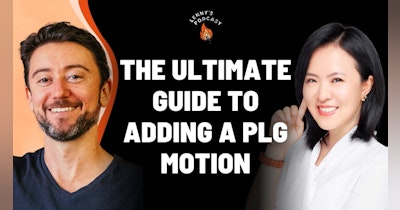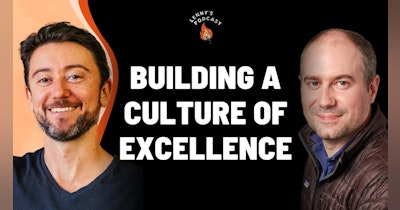Elena Verna has led growth at some of today’s most successful B2B businesses, including Miro as CMO, SurveyMonkey as SVP of Growth, and now at Amplitude as interim Head of Growth. She’s advised on growth for MongoDB, Clockwise, and Netlify (where she’s on the board).
She started out in data analytics at SurveyMonkey. There wasn’t a Chief Data Officer, so she started the Growth (Marketing and Product) function, where she saw bigger opportunities. Over her career she has worked with more than 17 companies. She transitioned to advising, thanks to Miro, and realized that’s what she loves doing more than taking on a full-time CXO role. She continues to do advising today.
She has a growth dictionary, to define things like PLG (product-led growth), PLS (product-led sales), in the show transcript, so check that out.
Key takeaways
- Successful companies layer both product- and sales-led motions, and the biggest mistake is to think you have to make a decision to choose one over the other.
- A lot of early-stage leadership-led recruiting today is selling rainbows, unicorns, and butterflies as opposed to talking about raw hardcore problems that exist. A trial period/advisory time helps both parties test things out, though it’s not the norm in Silicon Valley.
- When you are growing into a leadership role, you’re more motivated by the titles or grades (tangible). However, once in the leadership position, fulfillment comes from taking a company through one challenge after another and influencing company direction (less tangible), even though you have the fancy titles and financial security.
- In 10 years, product-led sales will box out top-down sales because PLS focuses on user value and has lower cost of acquisition.
Elena’s most fulfilling and most challenging positions yet ▶
Most fulfilling: 7.5 years at SurveyMonkey, where she “grew up” and felt most of her learning came from.
Most challenging: Miro, because helping a hypergrowth company means you have to grow at a similar rate or grow faster to keep up. Also, Covid hitting in the middle of a full repositioning and messaging of the product was stressful but gratifying.
What’s more important, product or growth?
The division between these roles isn’t clear, because the skills needed are so overlapping. She believes she is part of both. Both CPO and CMO roles exist today, so if you are in between, it’s not a well-defined space. Further, the function, roles, and titles in Growth aren’t as mature as in Product.
What’s changing in B2B vs. B2C growth? ▶
- B2B should be shiny and fun (compared to B2C); why isn’t it?
- Today, there’s a superficial ladder where an enterprise buyer makes the decision to buy B2B software and is not looking for shine, but just utility and efficiency, and they are not the actual users of the product.
- 1st wave: Cold enterprise product that was a feature checklist, mostly unusable/bulky with poor UX, where users couldn’t wait to get out and didn’t have the power to influence the decision to choose (e.g. Workday).
- 2nd wave (this decade): Decision-making power in B2B is being pushed back to the prosumer/user/employee. They are consumer-like, where they want the UX to feel a certain way. We’re slowly correcting the industry to provide solutions that are not only efficient but also effective, e.g. Slack built for their end users, not for enterprise buyers, and Amplitude sold bottom-up from the analytics data person.
(Check out Elena’s full article)
What exactly is “product-led growth” vs. “bottom-up”? ▶
PLG is part of a bigger growth model, where you have to answer:
- How to acquire users
- How to retain users
- How to monetize users
- You can be marketing-led, sales-led, or product-led across all or some of those areas, and you choose which motion makes more sense at your stage and context.
- For acquisition and monetization, PLG is a version or rebrand of traditional bottom-up sales, and there is a pressure on product to help with acquisition/qualified leads.
Advice for founders on product-led vs. sales-led ▶
- Never start with product-led acquisition; focus first on product-led retention, which consists of two KPIs, activation and engagement.
- Then, figure out which of the following your product is:
- 1-to-many relationship (e.g. Slack, Miro, Amplitude): focus on product-led for acquisition.
- 1-to-1 single-mode relationship (Snowflake): Rely on marketing or sales for acquisition. Most B2B companies fall here.
- Monetization:
- Self-serve is product-led.
- Otherwise: sales-led. Focus on large ACV; can be supported by product-led sales (PLS).
In order to succeed and own the market, you have to do both product-led and sales-led motions.
Why does PLG often get crushed when you move upmarket, and how do you avoid this? ▶
The pattern she sees is that PLG companies have user love and growth, which invites conversations about and signing of an enterprise contract, which feels exhilarating and addicting but leads to the mistake of going all-in with sales and the hiring of a sales team, which looks great until growth starts to slow.
In only 30% or less of the cases, an actual user of the product has access to the buyer/decision maker, which means sales is important and needed. However, the error is then deprioritizing PLG, e.g. Netlify and SurveyMonkey did this and overcorrected; but taking too long means the competition catching up and you’ll need re-invention of your growth model.
Defining product-led sales vs. sales-driven ▶
Product-led is when the product is able to generate some early usage without any involvement of people (whether it starts with product or marketing doesn’t matter). After some time you realize maybe there is a network effect or a use case for the bigger organization or other functions that can use it more, and then sales comes to engage. So usage occurs before the big buy, as opposed to being (traditionally) sales-driven.
Why product-led is the future of sales ▶
Product-led sales in 10 years will box out top-down sales-led organizations because PLS focuses on user value, has a lower cost of acquisition, and focuses on pipeline creation (usage) as opposed to marketing qualified leads, e.g. Atlassian is closing $200K deals self-serve, and she herself has bought Drift for $24K self-serve.
It’s not that enterprise buyers don’t hold the very important place of holding budgets, but the decision-making has moved to the user, so PLS is the best way to capture that intent.
Why is freemium the way to go, over trial? ▶
- A trial creates a superficial time bound for understanding the product. However, the challenge is that different users take different amounts of time to see value. A startup can easily evaluate a product in 7 days, but an enterprise likely cannot. Extending trials creates overhead in product and downstream, so she doesn’t recommend it.
- The biggest mistake with freemium is looking at just the optimization of conversion to paid, but that’s not the be-all and end-all. Figure out the strategic value.
How does freemium help achieve growth without sacrificing monetization?
- Does it help with indirect monetization like virality or network effects? If it does, probably have freemium.
- Does it suffice for every type of user regardless of complexity? If so, it’s probably a commodity feature and you should make it free.
- Does it help the aha moment? If so, have a proof of concept (POC) as part of free.
- Does it create habit loops via notifications or other channels? Then probably make it free.
Examples:
- MongoDB has a great freemium model where they give access to a shared database cluster as a POC (a serious product wouldn’t use this). There is no deadline for prototyping, so users can play around and eventually convert.
- Miro gives 3 editable boards for free—for some users that’s enough and they will never pay, which is OK because they will help acquire new users via sharing (indirect monetization for a different segment).
Hiring for growth ▶
Growth is an evolution, not a revolution; it’s a mindset the organization has to develop. That’s why she recommends finding someone internally for the first hire.
Hire for growth only when you have strong PMF, i.e.
- Retention, which takes time to measure (6 months to a year post-initial offering).
- Have some sort of acquisition and monetization loops to drive distribution.
This is a human edited summary of the podcast episode with Elena, by Gaurav Chandrashekar (@cggaurav, productscale.xyz). To listen to the full episode, go here.








